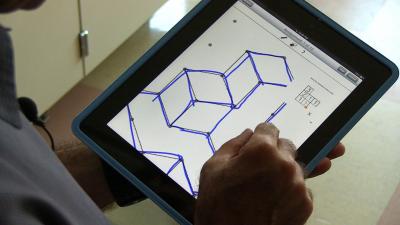Engineers at the University of California, San Diego, have developed an iPad app that helps students learn spatial visualization, an essential skill for doing well in science, math and engineering. They have been testing the app during a high school summer program at the Jacobs School of Engineering at UC San Diego, as well as on undergraduate students at the school.
Researchers are set to conduct more testing at UC San Diego and in local high schools this coming year. Their goal is to make the app publicly available by next summer. “As an engineer I visualize things before I build them ,” said Nate Delson, lecturer in mechanical engineering at UC San Diego. “I visualize them in 3D, I visualize them in 2D, and I imagine what they’re going to look like and how they will work before I build them. This process is called spatial visualization. Many kids learn spatial visualization skills by playing with construction toys, such as Legos, growing up. But some do not and it’s these students can struggle with technical subjects in college.”
The app was inspired by the research of Sheryl A. Sorby, a professor at Ohio State University. Sorby realized that many women, herself included, did not initially have strong spatial visualization skills. She developed a course on spatial visualization and showed that students who took her course not only became better at visualizing objects in 3D, but also got better grades in math, physics, engineering, and computer science. Students were also less likely to drop out of these majors.
“We wanted to broaden the reach of spatial visualization courses by using 3D computer graphics and touchscreen technology,” Delson said. “With our iPad app, users can rotate 3D objects with their fingertip to learn how they look from different perspectives.”
Researchers spent a lot of time developing a sketching feature for the app, which allows users to draw 3D shapes on a 2D grid. “The physical act of sketching is important for learning spatial visualization,” Delson explained.
The app also includes an immediate feedback feature that tells users whether their sketches are correct. If they are not, users can peek at the solution or try again on their own. “It is like having a private tutor sitting right next to you,” Delson said.
Teachers have access to a database on the app’s back end that shows exactly where students are struggling.
This summer, Delson and Lelli Van Den Einde, a lecturer in structural engineering at UC San Diego, tested the app on 23 high school students enrolled in a summer residential science outreach program here on campus. Eleven students in the group struggled with spatial visualization. After working with the app for about three weeks, more than half of them reached a level where they no longer needed training. Delson and Van Den Einde plan to present their results in June 2014 at the Annual Conference of the American Society for Engineering Education in Atlanta. “The students’ feedback was very positive,” Van Den Einde said.
Use in the classroom
Researchers expect that early adopters of the app will be engineering colleges that are currently teaching spatial visualization or want to add this subject to their curriculum but don’t have the manpower for a traditional classroom approach. The app could also be used in elementary, middle and high school, since it is natural to gain spatial visualization skills at a younger age. Students who want to learn on their own could also use it, thanks to the immediate feedback feature. Surgeons have told researchers that the app might be of interest to medical school students who are learning tasks such as how to operate surgical forceps during minimally invasive surgery.
In the future, researchers want to refine the data the app provides to instructors so they can learn more about how students learn. Are they erasing drawings? Are they peeking at solutions?
They also hope to make the app available on other platforms, such as Android tablets and Windows 8 computers.
Student and teacher feedback
“It’s a good tool,” said Bob Whitney, a physics and environmental sciences teacher at Westview High School in Poway. “I would definitely carve time in our schedule to use it.”
Whitney worked with Delson and Van Den Einde as they were testing the app on high school students enrolled in the COSMOS residential outreach program on the UC San Diego campus this summer. If he had access to the app during his regular classes, he could assess his students at the beginning of the year and work throughout the school year with those who struggle with spatial visualization skills, he said. Without the app, he may not notice that his students are struggling in this area until much later, he said.
“I found it challenging, but fun,” said David Thi, 16, a junior at San Bernardino High School in Southern California. “It’s like a video game.” The app would help students do better in math and engineering classes, he said. He plans to major in structural engineering at UC San Diego. “I like seeing things behind the scenes and making things,” he said.
Sara Brown, a senior at Clovis East High School in California’s Central Valley, said the app would help with geometry classes. Exercises weren’t hard, but they took a long time at first, she said. As she practiced, she got faster. The 17-year-old plans to major in engineering, probably at a University of California campus. “I like applying math and seeing how things work,” she said.


